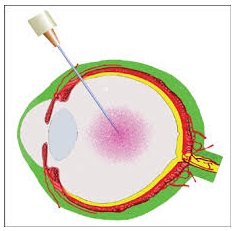Drug Delivery to the Posterior Segment of the Eye
Collaborator: Singapore Eye Research Institute (SERI)
For treating several disorders of the retinal area, the drug molecules need to be directly delivered to the posterior segment of the eye. The current standard of treatment is the monthly intravitreal injection, which is a very invasive procedure. There are various challenges associated with this mode of drug delivery, mainly in maintaining the required dose at the site of action, as well as overcoming several barriers to drug transport. The frequent administration of drugs via intravitreal injections can also cause sight-threatening complications such as hemorrhage, endophthalmitis, retinal detachment, cataract, etc.
| Schematic illustration of intravitreal injection |
|---|
 |
Encapsulating drugs in carriers, such as nanoparticles and liposomes can increase the bioavailability of the drugs at the site of action thus reducing the need for frequent drug administration. The efficacy of the drug delivery system may be affected by several factors such as charge, size, etc. of the carriers. The drug stability also needs to be optimized for the encapsulation process.
This project focuses on understanding the mechanisms of drug and carrier transport, controlling and optimizing the various factors that affect the encapsulation and delivery of drugs by various biocompatible carriers, using an ex vivo model. We have designed an ex vivo setup for studying the transport of small molecules and carriers across the sclera. Isolated porcine ocular tissues were mounted on modified Ussing chambers, and the drugs and carriers of interest are introduced in the donor chamber, and the receiver chamber is sampled to quantify the amount of transmitted drug. The setup was optimized using BSA as a model protein. Various model proteins were also analysed for transport to quantify transport and to study the changes in protein activity post-transport.

